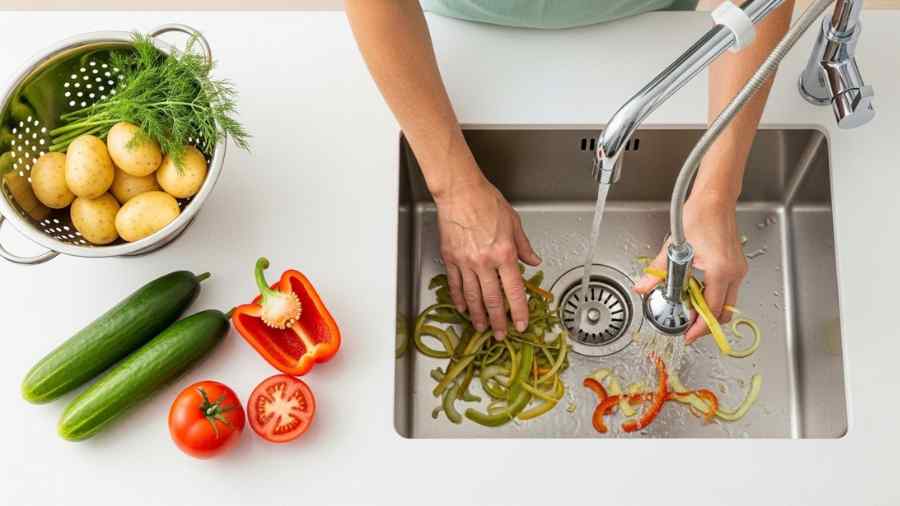How to Get Rid of Gnats in the Kitchen?

Few things are more frustrating than discovering tiny gnats hovering around your kitchen. These small flying insects seem to appear out of nowhere, buzzing near fruit bowls, drains, or even your sink. While they may seem harmless, gnats can quickly multiply and become a real nuisance if not addressed properly.
Keeping your kitchen clean and free from pests is just as important as having a beautiful, well-designed space, something experts in kitchen renovations Melbourne understand very well. A hygienic kitchen not only looks great but also provides a healthy environment for cooking and dining.
In this guide, we’ll explore what causes gnats, how to get rid of them using natural and chemical solutions, and how to prevent them from coming back.
What Are Gnats?
Gnats are small, flying insects that resemble tiny mosquitoes. They are often confused with fruit flies, but they belong to different species. Generally, the term “gnats” refers to several types of flies, including:
- Fruit gnats (fruit flies): Attracted to ripe or decaying fruits and vegetables.
- Drain gnats (drain flies): Thrive in moist environments such as sinks and drains.
- Fungus gnats: Usually found near indoor plants where the soil stays damp.
Gnats typically live for about a week, but they breed rapidly laying hundreds of eggs at a time. This means that even a small infestation can become a big problem fast.
What Causes Gnats in the Kitchen?
To effectively remove gnats, you first need to understand why they’re there in the first place. Gnats are drawn to moisture, food residue, and organic matter.
Common Causes Include:
- Overripe or rotting fruit: The sweet scent attracts fruit gnats instantly.
- Dirty drains: Food buildup and standing water create ideal breeding grounds.
- Damp sponges or dishcloths: Moisture and bacteria encourage gnats to gather.
- Trash bins and compost: Unsealed garbage or food scraps release strong odors.
- Indoor plants: Overwatering can create a breeding area for fungus gnats.
- Leaky pipes: Even small drips under sinks can attract moisture-loving insects.
Identifying the source is the first and most important step in eliminating the infestation.
Step-by-Step Guide: How to Get Rid of Gnats in the Kitchen
Here’s a detailed plan to help you remove gnats quickly and effectively.
Step 1: Identify the Type of Gnat
Not all gnats are the same, and each requires a slightly different approach.
- Fruit gnats: Often seen near fruits, wine bottles, or garbage bins.
- Drain gnats: Appear around sinks or drains and are most active at night.
- Fungus gnats: Found near indoor plants or damp soil.
Once you know what kind of gnat you’re dealing with, you can choose the most effective elimination method.
Step 2: Remove the Source
Gnats will keep returning unless you eliminate what’s attracting them.
- Discard overripe fruits and vegetables.
- Clean trash bins with hot soapy water and close the lids tightly.
- Wipe down kitchen counters regularly.
- Fix any leaky pipes or faucets.
- Avoid overwatering indoor plants.
Maintaining cleanliness is just as crucial as any pest control technique. Professionals working on kitchen renovations Melbourne always emphasize easy-to-clean designs that reduce dirt buildup and prevent pest problems.
Step 3: Clean Your Drains
Drains are one of the most common breeding grounds for gnats.
Here’s how to clean them:
- Pour 1 cup of baking soda down the drain.
- Add 1 cup of white vinegar.
- Let it sit for about 20 minutes while it fizzes.
- Rinse with boiling water to flush out residue and larvae.
You can also use a long brush or pipe cleaner to scrub the inside of the drain for extra cleaning power.
Step 4: Use Natural Traps
If you prefer not to use chemicals, there are several natural traps you can make using household ingredients.
1. Apple Cider Vinegar Trap
- Mix ½ cup of apple cider vinegar with a few drops of dish soap.
- Pour it into a small bowl and cover it with plastic wrap.
- Poke tiny holes in the top.
The vinegar attracts the gnats, while the soap breaks the surface tension, causing them to sink and drown.
2. Wine Trap
- Pour leftover wine into a glass and cover it with plastic wrap.
- Poke small holes.
The fermented scent lures gnats into the trap.
3. Fruit Trap
- Place a piece of overripe fruit in a jar.
- Cover with plastic wrap and make small holes.
Gnats fly in but can’t escape.
Natural traps are safe, affordable, and effective, especially for small infestations.
Step 5: Try Chemical Solutions (For Severe Infestations)
If natural remedies don’t work, you can use insecticides designed for gnats or fruit flies.
Recommended Options:
- Aerosol sprays: Use for immediate results, but avoid spraying near food.
- Sticky traps: Available in hardware stores, ideal for drain or fungus gnats.
- Drain cleaners: Specifically formulated for organic buildup in kitchen drains.
Always follow safety instructions carefully and ventilate the area when using chemical sprays.
Step 6: Clean All Kitchen Surfaces
Once you’ve eliminated the gnats, clean every surface thoroughly to remove lingering scents and food residue.
Use a mixture of white vinegar and water to wipe:
- Countertops
- Cabinet surfaces
- Appliance exteriors
- Sink areas
A clean kitchen is the best defense against another infestation. Just as thoughtful kitchen renovations Melbourne focus on both design and hygiene, your kitchen’s cleanliness determines how inviting it is not just for guests but for pests, too.
How to Prevent Gnats from Coming Back
Prevention is key to keeping your kitchen pest-free long term. Once you’ve removed gnats, follow these simple maintenance habits:
1. Store Food Properly
Keep fruits and vegetables in the refrigerator or sealed containers to minimize attraction.
2. Empty the Trash Regularly
Take out the trash daily, and clean the bin weekly with vinegar or disinfectant.
3. Maintain Dryness
Wipe spills immediately and ensure no standing water is left around sinks.
4. Clean Drains Weekly
Pour boiling water or vinegar down drains weekly to discourage breeding.
5. Use Essential Oils
Scents like lemongrass, lavender, and peppermint repel gnats naturally. Mix with water and spray around kitchen corners.
6. Monitor Indoor Plants
Avoid overwatering and use well-draining soil to prevent fungus gnat infestations.
Why Gnats Are More Common in Certain Kitchens
Gnats are drawn to specific conditions particularly warm, humid environments with food residue. Kitchens with poor ventilation or outdated drainage systems tend to attract more pests.
Modern kitchen renovations Melbourne often address these issues by incorporating improved airflow, sealed cabinetry, and efficient plumbing systems. These upgrades not only make your kitchen more beautiful but also reduce the chances of attracting insects like gnats.
Eco-Friendly Ways to Keep the Kitchen Fresh
Instead of relying on chemicals, you can maintain a gnat-free kitchen using eco-friendly approaches.
Try These Tips:
- Place basil or mint plants on your windowsill they naturally repel gnats.
- Use lemon peels near sinks to keep drains smelling fresh.
- Make a natural cleaner with vinegar, lemon juice, and water.
These natural methods are gentle on your home and the environment, aligning with the sustainable design principles many kitchen renovations Melbourne professionals promote today.
Common Mistakes to Avoid
- Ignoring the Source: Killing adult gnats won’t help if eggs are still present in drains or trash bins.
- Overusing Chemical Sprays: These provide short-term relief but don’t solve the root cause.
- Leaving Food Exposed: Even a small fruit peel can attract a swarm.
- Neglecting Plant Care: Overwatering plants is one of the most overlooked causes.
- Forgetting to Clean Regularly: Weekly cleaning routines keep pests away for good.
Avoiding these mistakes ensures long-lasting results and a healthier kitchen environment.
When to Call a Professional
If you’ve tried all the methods above and the problem persists, it might be time to call in a pest control specialist. Persistent infestations can indicate hidden breeding spots such as within walls or plumbing systems.
Professional pest control experts can inspect your home, identify hidden sources, and apply targeted treatments safely.
The Connection Between Clean Design and Pest Prevention
A functional kitchen design goes hand-in-hand with cleanliness. A cluttered or poorly ventilated kitchen creates ideal hiding spots for pests.
Modern kitchen renovations Melbourne incorporate practical solutions like:
- Seamless countertops that are easier to clean.
- Built-in ventilation systems that reduce humidity.
- Hidden trash compartments that prevent odor buildup.
- Proper drainage layouts to avoid stagnant water.
Investing in such designs not only makes your kitchen more elegant but also keeps it naturally resistant to gnats and other insects.
Conclusion
Gnats may be small, but they can cause big frustration when they invade your kitchen. The good news is that with a few simple steps identifying the cause, cleaning thoroughly, and setting traps you can eliminate them for good.
Prevention is just as important as removal. Keep your kitchen clean, store food properly, and fix any moisture problems promptly.
And if you’re planning a remodel or upgrade, consulting kitchen renovations Melbourne experts can help you design a cleaner, smarter, and more pest-resistant kitchen from the start.
With the right approach, your kitchen can stay stylish, functional, and completely gnat-freeletting you focus on what truly matters: cooking, dining, and enjoying your space.



